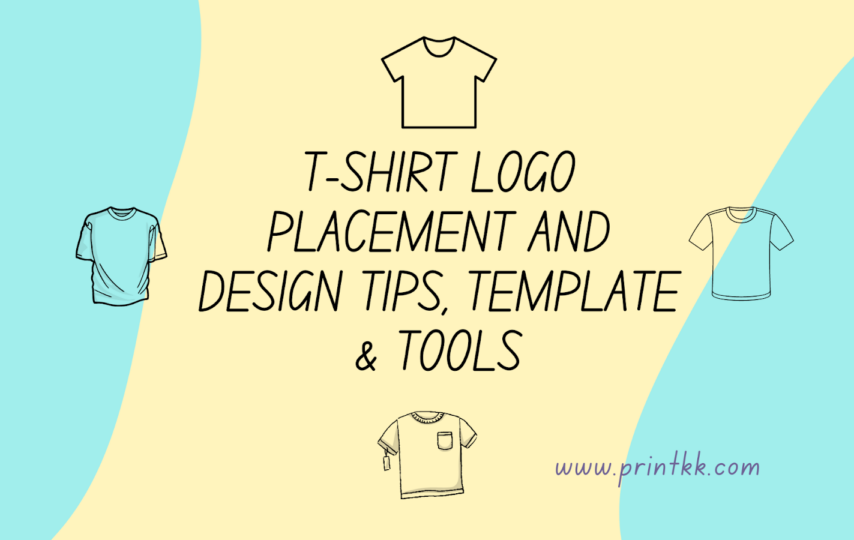Explore the art of T-shirt logo placement with our guide, offering insights for entrepreneurs, artists, and brands. Learn to position logos perfectly and use innovative design tools effectively. Here, you’ll find strategies to transform T-shirt concepts into impactful wearable art, elevating your designs and brand identity.
Introduction
Choosing the right placement for a logo on a T-shirt can be surprisingly challenging for businesses and designers alike. It’s not just about aesthetics; it’s a crucial marketing decision that can significantly impact brand visibility and recognition. Often, entrepreneurs, artists, and organizations struggle with this seemingly simple task, unsure of how to balance creativity with practicality.
The consequences of poor logo placement are more than just a fashion faux pas. It can lead to reduced brand exposure, missed marketing opportunities, and even a disconnect with your target audience. After all, a logo that’s too intrusive or awkwardly placed can turn off potential customers, while one that’s too subtle might go unnoticed.
Fortunately, there are strategies and guidelines that can transform this challenge into an opportunity for brand enhancement. By understanding the principles of effective logo placement on T-shirts, you can ensure that your brand not only captures attention but also resonates with your audience in a meaningful way.
Logo Design Placement Locations
When considering logo placement on T-shirts for various audiences such as entrepreneurs, small business owners, designers, artists, and dropshippers, it’s essential to understand the variety of locations and their impact. Each placement offers a unique way to showcase a brand or design, catering to different styles and purposes. Here’s an overview of common logo placement options:
- Chest Area Design Placement
This location is highly visible and ideal for brand logos. It’s a classic choice for corporate and professional designs, ensuring the logo is seen during face-to-face interactions.
- Full Front Design Placement
This location is highly visible and ideal for brand logos. It’s a classic choice for corporate and professional designs, ensuring the logo is seen during face-to-face interactions.
- Oversize Front Design Placement
Embraces a more modern, fashion-forward approach. It’s great for artistic designs that demand attention and can be used to convey a strong message or showcase detailed artwork.
- Back (Upper or Lower) Design Placement
The upper back is excellent for additional branding or slogans, while the lower back can be used for more subtle or playful designs. This placement is often seen in sports jerseys and event merchandise.
- Sleeve Design Placement
Offers a sophisticated and subtle way to display logos or text. It’s a great option for brands looking for a discreet yet stylish way to include their logo or for adding sponsor details.
- Hem Design Placement
A contemporary choice, placing a design on the hem adds a unique and unexpected element to T-shirt branding. It’s perfect for those looking to differentiate their brand with a modern touch.
- Nape of the Neck Design Placement
Provides a discreet branding option, often used for minimalist designs or additional branding elements. It’s seen in both casual and corporate wear.
- Pocket Design Placement
Ideal for small, detailed logos, this placement adds a classic touch. Suitable for more formal T-shirt designs or when combining functionality with branding.
- Other Common Logo Placement Options
Includes unconventional areas like the side, collar, or an all-over print. These options cater to unique design needs and can make a T-shirt stand out in a crowded market.
10 Best T-Shirt Logo Design Tips
Creating a compelling T-shirt logo is an art that balances aesthetics, branding, and market appeal. These 10 tips offer a comprehensive guide for anyone in the print-on-demand industry looking to design logos that capture attention and convey their brand’s message effectively. From understanding your audience to ensuring legal originality, each tip is crucial in crafting a logo that stands out while resonating with your target market. Whether you’re a seasoned designer or a business owner starting out, these insights will help you create impactful, memorable T-shirt logos.
- Understand Your Audience
Research to create designs that resonate with your target market.
- Simplicity is Key
Opt for clean, uncluttered designs that are easily recognizable.
- Color Matters
Choose colors that complement the T-shirt and enhance the logo.
- Placement Precision
Experiment with different locations for maximum impact.
- Size Appropriately
Ensure the logo is neither too large nor too small.
- Consider T-shirt Color and Material
Adapt your logo design to suit different backgrounds and textures.
- Brand Consistency
Maintain your brand’s style and ethos in the logo design.
- Test Your Designs
Gather feedback to refine and perfect the logo.
- Stay Trend-Aware
Keep up with design trends while maintaining a timeless aspect.
- Legality and Originality
Ensure the design is original and doesn’t infringe on copyrights.
How to Print Images on Shirts
Printing images on shirts is a crucial process for businesses in the print-on-demand sector. It involves several steps and considerations to ensure the final product meets both aesthetic and quality standards. Here’s a breakdown of the key aspects to consider:
Selecting the Right Printing Method
Choose between techniques like screen printing, DTG, or heat transfer based on design complexity and order volume.
Quality of Materials
The type of fabric affects the print’s appearance and durability.
Image Resolution
Use high-resolution images to avoid poor print quality.
Shirt Color Consideration
The color of the shirt can influence how the printed image looks.
Test Printing
Conduct a test run to ensure color and design accuracy.
Care Instructions
Proper care extends the print’s life.
Trend Awareness
Keep designs current and appealing.
Image Placement
Positioning is key for visual impact.
Legal Compliance
Ensure image use complies with copyright laws.
Sustainable Practices
Consider environmentally friendly printing methods.
This guide is intended for a wide range of audiences in the print-on-demand industry, focusing on practical and effective techniques for printing images on shirts.
T-Shirt Logo Placement Template
Printing images on shirts is a nuanced process that can significantly impact the brand perception and design appeal. Each logo placement on a T-shirt serves a distinct purpose and can cater to different branding strategies. Here’s a detailed look at various logo placements:
Chest Area:
The chest is the most common placement for logos, especially for corporate branding. It’s highly visible during conversations and perfect for logos that need immediate recognition.
Full Front:
Ideal for bold and creative designs, the full front placement allows for maximum visibility. It’s perfect for making a statement or showcasing large graphics.
Upper Back:
Often used for additional branding elements or messages, the upper back placement is visible in a crowd and is frequently used for team shirts or event merchandise.
Sleeve:
The sleeve is an excellent spot for subtler branding or sponsor logos. It offers a stylish alternative to the more traditional placements.
Lower Back:
Gaining popularity, especially in casual and streetwear designs, the lower back placement is trendy and offers a unique visibility that differs from the more conventional front and back placements.
Nape of the Neck:
For minimalist and discreet branding, the nape of the neck is an elegant choice. It’s a subtle nod to brand identity without overwhelming the shirt’s design.
These placements, as illustrated in the accompanying images, offer a comprehensive guide for anyone in the print-on-demand industry looking to explore different ways to position their logos on T-shirts.
T-Shirt Logo Placement Tool
When considering tools for T-shirt logo placement, there are several notable options available online:
- PrintKK: Revolutionizing Print-on-Demand Services
PrintKK emerges as a game-changer in the realm of print-on-demand services. This innovative platform is designed to empower creators, businesses, and individuals with the ability to effortlessly materialize their custom designs into high-quality printed products like custom t-shirts, custom rugs and etc. Similar to other industry players, PrintKK excels in transforming digital art into tangible merchandise.
- Jennifer Maker’s T-Shirt Ruler Guide:
This tool is designed for perfect placement of designs on T-shirts. You can create these rulers yourself using cardstock or plastic, and they are suitable for all T-shirt sizes from infant to adult. Jennifer Maker’s guide provides detailed instructions on making and using these rulers, including free SVG cut files for the rulers, which can be particularly helpful for those using a Cricut cutting machine.
- Mockover’s Logo Projection Tool:
This online tool offers a unique way to place logos on various products, including T-shirts. It allows you to upload a picture of the product and then define areas for logo placement. You can add your logo and adjust its positioning, size, and orientation on the product image. This tool is beneficial for visualizing how a logo would look on different parts of a T-shirt.
- Adobe Express Free Online T-Shirt Logo Maker:
Adobe Express provides a platform where you can create logos specifically for T-shirts. It offers a range of templates and customization options, allowing you to decide on a visual style, generate logo options, and add personal touches. This tool is handy for those who are looking to design logos from scratch with customizable options.
- Etsy’s T-Shirt Alignment Tools:
On Etsy, you can find a variety of digital downloads for T-shirt alignment tools. These tools come in different formats like SVG, DXF, and PDF and are designed to help with precise placement of designs on T-shirts. They are particularly useful for those looking for ready-made and easily accessible alignment guides.
- Logo GRID It! by HeatPressNation:
This tool is designed for aligning chest graphics on T-shirts. It’s used in conjunction with the TEE SQUARE IT! tool to ensure perfect placement of images on shirts. This tool could be especially useful for those involved in professional T-shirt printing or production.
Conclusion
In summary, effective logo placement on T-shirts is crucial in print-on-demand industries. It’s not just about aesthetics but also about making a meaningful impact on brand visibility and audience connection. Tools like PrintKK’s T-Shirt Logo Placement Tool simplify this process, enabling entrepreneurs, designers, and businesses to experiment and find the perfect balance for their brand. Ultimately, the right logo placement can significantly elevate a T-shirt from a simple garment to a powerful statement of brand identity and style.
FAQs
Where should logo be placed on a shirt?
The optimal logo placement on a shirt is often the left chest for visibility and recognition. Other options include the upper back, sleeve, or hem, depending on your branding strategy and audience preference. Each position caters to a different aesthetic and can complement your design effectively.
How do you position a t-shirt design?
Design placement on T-shirts is crucial, with the center chest area being most prominent. For subtlety, the upper left chest is favored, while the upper back ensures visibility from behind. Sleeve or lower back placements offer creative flair. The right choice enhances the shirt’s impact, aligning with the brand and audience preferences.
Should shirt logo go on left or right chest?
The left chest is preferred for logo placement on T-shirts, catering to natural eye movement for better visibility and recognition. While the right side may serve creative purposes, the choice should align with the brand’s identity and audience expectations, ensuring a harmonious design.








